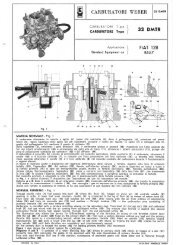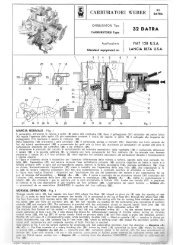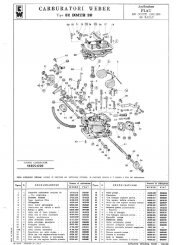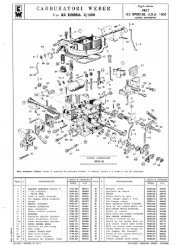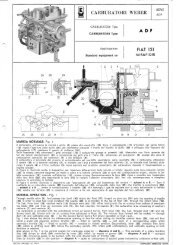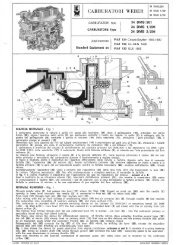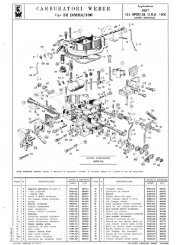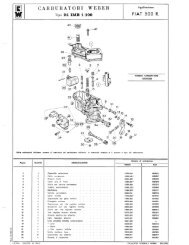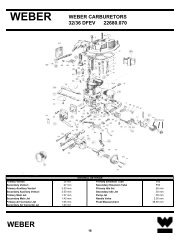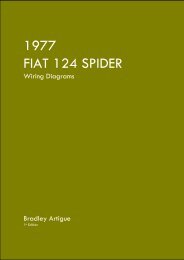Engine Maintenance and Modification Bradley Artigue
FIAT 124 Spider Engine Maintenance + Modification - Artigue.com
FIAT 124 Spider Engine Maintenance + Modification - Artigue.com
- No tags were found...
Create successful ePaper yourself
Turn your PDF publications into a flip-book with our unique Google optimized e-Paper software.
FIAT 124 Spider<br />
<strong>Engine</strong> <strong>Maintenance</strong> + <strong>Modification</strong><br />
11.5 Carburetors<br />
We discussed the stock carburetors earlier in this book. The carburetors were<br />
reasonably good matches to the engine size; however, a general rule is that the cars<br />
were always slightly under-carbureted. Every time an owner installs a DHSA2 on a car<br />
previously fitted with the DHSA1 the performance increases. Simply put, the DHSA2<br />
allows more air into the motor. Every Spider 2000 owner who replaced the ADHA <strong>and</strong><br />
manifold with a DFEV, ADF, or ADFA has felt his car spring to life. This section deals<br />
with good swaps <strong>and</strong> good new carburetors to install on your car.<br />
Most folks who are considering a carburetor swap will likely stay away from the<br />
pneumatic carburetors. Truth be told they aren’t as fun to drive; the secondary always<br />
lags behind the first regardless of how hard you press the gas pedal. They were<br />
designed to deliver the secondary fuel at an “appropriate” time, which is fine for fuel<br />
economy <strong>and</strong> emissions, but not so much for overall driving fun. The pneumatic<br />
carburetors are harder to find parts for <strong>and</strong> their unpopularity in modern applications<br />
makes parts availability scarcer every day.<br />
Mechanical carburetor swaps are very easy on the Spiders. The easiest <strong>and</strong> most<br />
popular is done by owners of the Spider 2000. The Spider 2000 owner can buy an 1756<br />
intake manifold <strong>and</strong> the Weber 32ADFA carburetor <strong>and</strong> install them in the same locations<br />
as the old carburetor. Plug in the fuel lines, distributor vacuum pulse line, cold start<br />
hoses, <strong>and</strong> linkages, <strong>and</strong> get an immediate performance increase. The two carburetors<br />
are externally near identical, meaning that the hoses <strong>and</strong> other pieces line up nicely. The<br />
real gain for the Spider 1756 <strong>and</strong> 2000 owner is from the other Weber ADF, the 34 ADF.<br />
Available new from most parts vendors the 34 is a very large <strong>and</strong> powerful carburetor<br />
with no unnecessary components. It has connections for the distributor vacuum <strong>and</strong><br />
vapor recovery; otherwise it is just a fine Weber carburetor that adds instant fun to the<br />
2000cc vehicles. The 34 ADF should always be mounted on the 1756 ADFA manifold.<br />
If it fits your budget, consider the following combinations:<br />
Table 11: <strong>Engine</strong> Component Combinations<br />
Block <strong>and</strong> Head Intake Manifold Exhaust System Recommended Carburetor<br />
2000cc<br />
2000 FI Cylinder Head<br />
Stock Pistons<br />
1756cc 2000cc FI 4-2-1 Weber 34 ADF<br />
or<br />
Weber 28/36 DFEV<br />
2000cc<br />
1756 Cylinder Head<br />
Stock Pistons<br />
1756cc 1756cc 4-2-1<br />
or<br />
2000cc FI 4-2-1<br />
Weber 34 ADF<br />
or<br />
Weber 28/36 DFEV<br />
or<br />
Weber 36 ADL<br />
87



